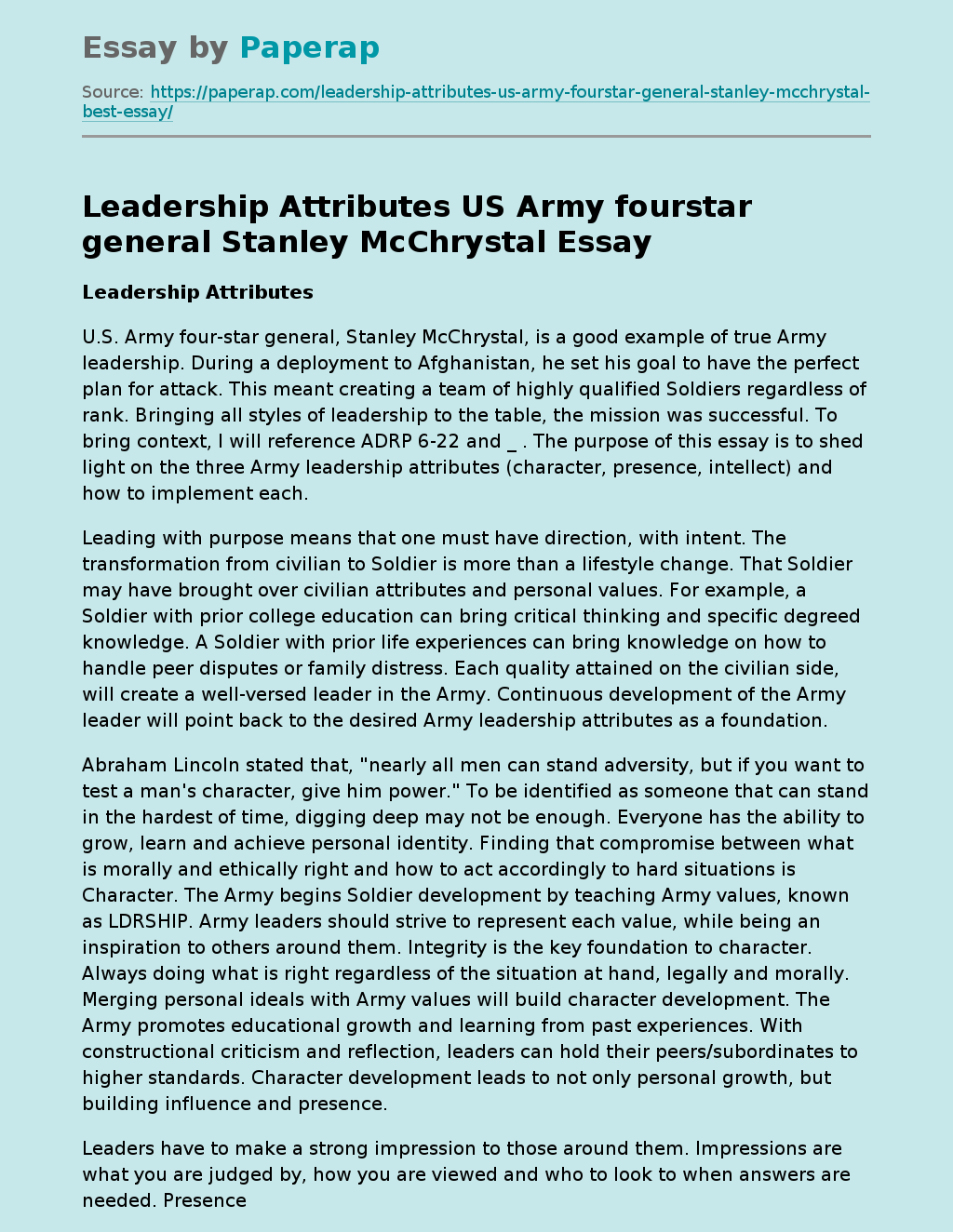Leadership Attributes US Army fourstar general Stanley McChrystal
Leadership Attributes
U.S. Army four-star general, Stanley McChrystal, is a good example of true Army leadership. During a deployment to Afghanistan, he set his goal to have the perfect plan for attack. This meant creating a team of highly qualified Soldiers regardless of rank. Bringing all styles of leadership to the table, the mission was successful. To bring context, I will reference ADRP 6-22 and _ . The purpose of this essay is to shed light on the three Army leadership attributes (character, presence, intellect) and how to implement each.
Leading with purpose means that one must have direction, with intent. The transformation from civilian to Soldier is more than a lifestyle change. That Soldier may have brought over civilian attributes and personal values. For example, a Soldier with prior college education can bring critical thinking and specific degreed knowledge. A Soldier with prior life experiences can bring knowledge on how to handle peer disputes or family distress. Each quality attained on the civilian side, will create a well-versed leader in the Army.
Continuous development of the Army leader will point back to the desired Army leadership attributes as a foundation.
Abraham Lincoln stated that, “nearly all men can stand adversity, but if you want to test a man’s character, give him power.” To be identified as someone that can stand in the hardest of time, digging deep may not be enough. Everyone has the ability to grow, learn and achieve personal identity. Finding that compromise between what is morally and ethically right and how to act accordingly to hard situations is Character.
The Army begins Soldier development by teaching Army values, known as LDRSHIP. Army leaders should strive to represent each value, while being an inspiration to others around them. Integrity is the key foundation to character. Always doing what is right regardless of the situation at hand, legally and morally. Merging personal ideals with Army values will build character development. The Army promotes educational growth and learning from past experiences. With constructional criticism and reflection, leaders can hold their peers/subordinates to higher standards. Character development leads to not only personal growth, but building influence and presence.
Leaders have to make a strong impression to those around them. Impressions are what you are judged by, how you are viewed and who to look to when answers are needed. Presence is a big part of leading. Some examples of presence could be medical readiness, psychological and spiritual. (ADRP 6-22) The effectiveness of being a leader is increased when developing the following areas:
Military and Professional Bearing: military custom/courtesies, posture, and competence.
Fitness: Well-being of the Soldier.
Confidence: Self-confidence, demeanor
Resilience: continuously pursuing excellence
The Army understands that a holistic leader demands presence everywhere he/she may go. This professionalism is displayed within the ranks, to civilians and ultimately other nationalities when deployed. The wining spirit of the Army is carried out in its leadership. Regardless of the situation, Army leaders need to go one step further and pursue increasing intellect.
An Army leaders intelligence draws on the mental tendencies and resources that shape conceptual abilities, which are applied to ones duties and responsibilities. (www.usarmyleader.com) Intellect will define a leader as someone who spent time learning a subject. This leader can now think creatively. A good example would be, a mass movement in support of a natural disaster. The Army leader should have spent time learning the environment, preparing for unexpected situations and briefing Soldiers. Research will prove that the Soldier is confident in his/her abilities when challenged. Components that will affect the intellect of an Army leader are:
Mental agility: The ability to adapt without pause. Critically thinking while making decisions is a strong point when applying mental agility to intellect.
Sound judgment: Trial and error provide a large amount of experience to reign from. Leaders need to make quick and conscious judgments, in return affecting everyone around them. Thinking of peers from all ranks of the Army, a leader should present their thoughts in a clear manner.
Innovation: Understanding creative thinking transfers to innovation. Army leaders who are innovative, set themselves up for success above peers. New and old problems need to be addressed with new solutions as the Army is ever evolving.
Interpersonal tact: Perception is a large part of communication. Communicating with peers/subordinates tactfully.
Expertise: Combining all areas of intellect. This skill will touch on tactical knowledge, technical knowledge, joint knowledge, and cultural/geopolitical knowledge. A leader with expertise will be able to handle the responsibility of making decisions on an organizational level.
ADRP 6-22
Army leaders that take initiative and accept new creative ideas, will be the future of the Army.
In conclusion, I covered Army leadership attributes and how to implement each. Becoming a leader is a task that requires self-evaluation and acceptance of a challenge. From unit level up, the Army relies on Soldiers stepping up to create an influential environment. The take away from Army attributes will prepare Soldiers for a future transition to civilian life.
Leadership Attributes US Army fourstar general Stanley McChrystal. (2019, Dec 14). Retrieved from https://paperap.com/leadership-attributes-us-army-fourstar-general-stanley-mcchrystal-best-essay/

